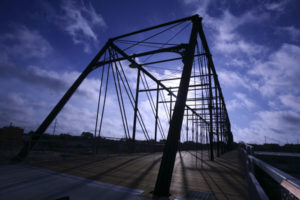
The reopening of this bridge to bike and foot traffic provides a much needed connection for the revitalizing East Side and Downtown. Great article by Colin McDonald.
After 28 years of barricades, demolition threats, ownership disputes and fundraising shortfalls, the Hays Street Bridge is open again.
On Tuesday, several hundred East Side residents, bicycle riders, engineers, historic preservationists and politicians gathered on a concrete ramp to the bridge to mark its rebirth as a bike-and- pedestrian passageway.
“We are here to welcome this old lady back,” said East Side advocate Nettie Hinton, just before cutting the ribbon to the restored span, which stretches from Austin Street to near Cherry Street.
The new bridge decking creaked under the weight of the crowd as it admired the fist-sized bolts from the 1880s and the view of downtown San Antonio.
Doug Steadman, who spent the past 10 years working alongside Hinton to save the bridge, just smiled.
“What a beautiful place to have parties,” he said the day before as he walked the bridge. “Maybe even a wedding.”
It’s been a long transition.
In 1982, the wrought-iron bridge was deemed too dangerous for vehicles and closed.
The bridge owner and the city’s code compliance office talked of demolition.
That’s when Hinton started her campaign and petition to save the bridge. The San Antonio Conservation Society threw its political clout behind the effort.
In 1999, Steadman was “bit by the bridge bug,” as Hinton put it, after hearing about a bridge restoration in Waco. He and his wife, Jurene were as tireless as Hinton.
“The preservationists were shamelessly persistent,” said architect Ann McGlone, who was San Antonio’s historic preservation officer from 1993 to 2008.
Hinton grew up listening to the clatter of the bridge’s wooden deck every time a car drove it and could not imagine the East Side without it.
For Steadman, 83, the elegance of the 19th century Whipple-Phoenix span, held together with pins, was too important to let slip away.
To help save it, the bridge was designated a historic structure by the city, the state and the Texas Historical Commission. Fundraisers were held and $200,000 was raised toward the $3.7 million total cost. A federal grant paid the remainder.
Reconstruction began in May 2009.
Now there are promises from the city of more bike lanes and sidewalks to connect with the bridge.
Hinton has her eye on the 1.5 acres of land below the bridge, and she told the crowd Tuesday there was plenty of work left to be done.
“We have a park to develop,” she said.


